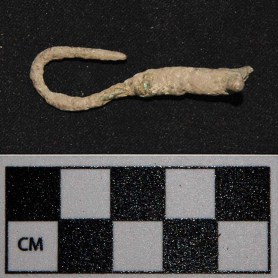Nixtun Chʼichʼ
Nixtun-Chʼichʼ is an ancient Maya archaeological site located in the Petén Basin region of Guatemala. It is notable for its unique grid pattern layout, which distinguishes it from the more commonly irregular or radial layouts of other Maya cities. This planned urban layout, with its straight streets and city blocks, suggests a highly organized society and has implications for understanding Maya urban planning and social organization.
Location and Discovery[edit | edit source]
Nixtun-Chʼichʼ is situated on the shores of Lake Petén Itzá, in the modern department of Petén, Guatemala. The site's proximity to water sources and fertile land would have been advantageous for its inhabitants, supporting agriculture and trade. Archaeological investigations in the area have revealed that Nixtun-Chʼichʼ was occupied during the Preclassic period of Maya history (circa 2000 BCE to 250 CE), with evidence suggesting that the site continued to be significant into the Classic period (circa 250 CE to 900 CE).
Archaeological Significance[edit | edit source]
The discovery of Nixtun-Chʼichʼ has provided valuable insights into Maya urban planning. The city's grid layout is an anomaly among Maya sites, which typically feature a more organic arrangement of structures centered around ceremonial and administrative buildings. This planned urbanism indicates a level of political and social organization that challenges previous assumptions about Preclassic Maya societies.
Excavations at Nixtun-Chʼichʼ have uncovered a variety of structures, including residential buildings, temples, and plazas. The presence of a central axis and aligned buildings suggests that the city's layout was carefully planned from its inception. This organization may have facilitated efficient communication, transportation, and administration within the city.
Cultural and Historical Context[edit | edit source]
The grid pattern of Nixtun-Chʼichʼ raises questions about the influences on Maya urban design and the extent of interaction between the Maya and other Mesoamerican cultures. Some scholars speculate that the grid layout could reflect a broader Mesoamerican tradition of urban planning, seen in other civilizations such as the Olmec and the Teotihuacanos. Alternatively, it may represent an independent development within the Maya cultural sphere.
The strategic location of Nixtun-Chʼichʼ, along with its unique layout, suggests it played a significant role in regional trade networks. Goods such as obsidian, jade, and ceramics would have been traded, contributing to the city's economic and political power. The site's prominence during the Preclassic period also highlights the complexity and diversity of Preclassic Maya society, which is often overshadowed by the achievements of the Classic period.
Research and Conservation[edit | edit source]
Ongoing archaeological research at Nixtun-Chʼichʼ is crucial for further understanding the site's significance and the broader aspects of Maya civilization. Efforts to conserve the site face challenges due to natural degradation and the potential for looting. Preservation of Nixtun-Chʼichʼ is essential for future generations to study and appreciate the complexities of Maya history and culture.
Conclusion[edit | edit source]
Nixtun-Chʼichʼ represents a fascinating aspect of Maya civilization, offering unique insights into urban planning, social organization, and cultural exchange in the Preclassic period. Its grid layout challenges traditional views of Maya city planning and suggests a level of sophistication and centralization that warrants further study. As research continues, Nixtun-Chʼichʼ will undoubtedly contribute to a deeper understanding of the ancient Maya and their remarkable achievements.
Search WikiMD
Ad.Tired of being Overweight? Try W8MD's physician weight loss program.
Semaglutide (Ozempic / Wegovy and Tirzepatide (Mounjaro / Zepbound) available.
Advertise on WikiMD
|
WikiMD's Wellness Encyclopedia |
| Let Food Be Thy Medicine Medicine Thy Food - Hippocrates |
Translate this page: - East Asian
中文,
日本,
한국어,
South Asian
हिन्दी,
தமிழ்,
తెలుగు,
Urdu,
ಕನ್ನಡ,
Southeast Asian
Indonesian,
Vietnamese,
Thai,
မြန်မာဘာသာ,
বাংলা
European
español,
Deutsch,
français,
Greek,
português do Brasil,
polski,
română,
русский,
Nederlands,
norsk,
svenska,
suomi,
Italian
Middle Eastern & African
عربى,
Turkish,
Persian,
Hebrew,
Afrikaans,
isiZulu,
Kiswahili,
Other
Bulgarian,
Hungarian,
Czech,
Swedish,
മലയാളം,
मराठी,
ਪੰਜਾਬੀ,
ગુજરાતી,
Portuguese,
Ukrainian
Medical Disclaimer: WikiMD is not a substitute for professional medical advice. The information on WikiMD is provided as an information resource only, may be incorrect, outdated or misleading, and is not to be used or relied on for any diagnostic or treatment purposes. Please consult your health care provider before making any healthcare decisions or for guidance about a specific medical condition. WikiMD expressly disclaims responsibility, and shall have no liability, for any damages, loss, injury, or liability whatsoever suffered as a result of your reliance on the information contained in this site. By visiting this site you agree to the foregoing terms and conditions, which may from time to time be changed or supplemented by WikiMD. If you do not agree to the foregoing terms and conditions, you should not enter or use this site. See full disclaimer.
Credits:Most images are courtesy of Wikimedia commons, and templates Wikipedia, licensed under CC BY SA or similar.
Contributors: Prab R. Tumpati, MD





